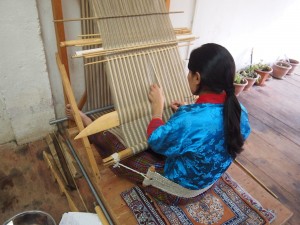
Zangmo learned to weave watching her mother while still a little girl. Today, the skills she acquired some three decade ago, feeds her entire family.
She weaves around two ghos or kiras per week (depending on the orders she receives from customers). And that fetches her around Nu 8,000.
For weaving these ancient traditional Bhutanese patterns and designs, she uses as most others in Western and Central Bhutan, pedal looms. Weaving in Bhutan is as ancient as Bhutanese culture itself. In the earlier days, yak and sheep wool, known as yathra, were woven as cloaks to shield oneself from the rain. Today, yathra wool is woven as coats, ghos, kiras and the lot.
Like Zangmo, women from eastern Bhutan are known for the exotic patterns they weave out of back strap looms. Depending on the material and the textile patterns used, to weave one gho or a kira on a back strap loom can take anywhere from 10 days to six months.
In Bhutan, every region has its own specialty. For example, bura (raw silk) is popular in Trashigang. In Kurtoe or Lhuntse, sesho (fine silk) is very widely used. And, of course, yathra is the trademark of Bumthang and western parts of the country. What makes them special is that all the weavers in Bhutan are women.
Come winter, and the village of Khoma in Kurtoe, Lhuentse reverberates with the sound of the wooden beater hitting the warp as the women weave the famous kishuthara.
Kishuthara is special in that the silk patterns are one of the most colorful and intricately woven Bhutanese fabrics in the country. Its origins go back several centuries and each kishuthara has the signature of its weaver who designs patterns depending on the occasion that the kishuthara is to be worn at – as the occasions grow in importance, so do the intricacy and denseness of the patterns.
It is a common sight, especially after the harvest season in Khoma, to find women in groups of six to ten sitting upright in rows with their back-strap looms, sheltered by bamboo canopies, in the harvested paddy fields weaving. The youngest weaver in the group could be anywhere between eight to ten years old. Such is the demand for kishuthara in Bhutan that the skills have been passed down from one generation to another.

As beginners, the young girls learn to weave on cotton fabrics using silk threads for the intricate designs, seated beside the watchful eyes of their mothers. A gho or kira of the kishuthara fame can fetch the weaver anything from Nu 40,000 to 75,000.
Learning to weave a kishuthara is not easy. There are a number of procedures involved before weavers can finally get started. They have to first learn to boil the silk in a citric mixture to retain the original color of the silk, before drying it in the sun. The dry silk is then spun into a ball to form a continuous yarn which is stretched on two stands before it is finally spread out vertically on the loom.
There are three types of Kishuthara: the ngagsham with black background, oshom with blue background and the white kishuthara.
In the National institute of Zorig Chusum, in Thimphu, girls are mostly aged 17 to 25 and come from all over the country, though most of them are from the east where the best weavers come from. Bhutanese textiles represent a rich and complex repository of a unique art form. They are recognized for their abundance of color, sophistication and variation of patterns, and the intricate dyeing and weaving techniques.
As textile production moved beyond the confines of clothing to artistic expressions of individuals and communities, patronage from the royal household was vital. The ancestral home of the monarchs, Lhuentse is historically recognized as the home of the most celebrated weavers in the country.
The role and influence of Royal women in sustaining and furthering the weaving tradition has truly helped Bhutanese weavers. Trongsa Penlop Jigme Namgyal built the Wangdichholing palace in 1857, and around the same time the loom houses (thagchem) accommodating 30 to 40 weavers were built near the palace and existed until the mid 1900s.
The sister of the second King, Ashi Wangmo, is credited to have introduced the horizontal loom from Tibet in the 1930s. Her Majesty the Queen mother, Ashi Sangay Choedon Wangchuck continuous to extend royal patronage to the textile industry. Her Majesty’s interest and intervention have revitalized Bhutanese textiles, given the industry the much needed impetus within the country and brought world attention to Bhutanese textiles.
Today, Bhutanese textiles have reached new heights of dynamism and innovation; they are valued not only for their economic viability, but also as a symbol of Bhutan’s artistic heritage that commands appreciation.
The Bhutan Textile Museum, since its establishment in 2001, has generated national and international attention and has garnered a substantial collection of antique textile artifacts, exclusive to Bhutan.
The objective of setting up the museum is to promote Bhutan’s achievements in the field of textile arts and to sustain and promote interest of the weavers to continue the traditional textile patterns. The museum also envisions of becoming the centre for textile studies and research apart from promoting the history and culture of Bhutan.

